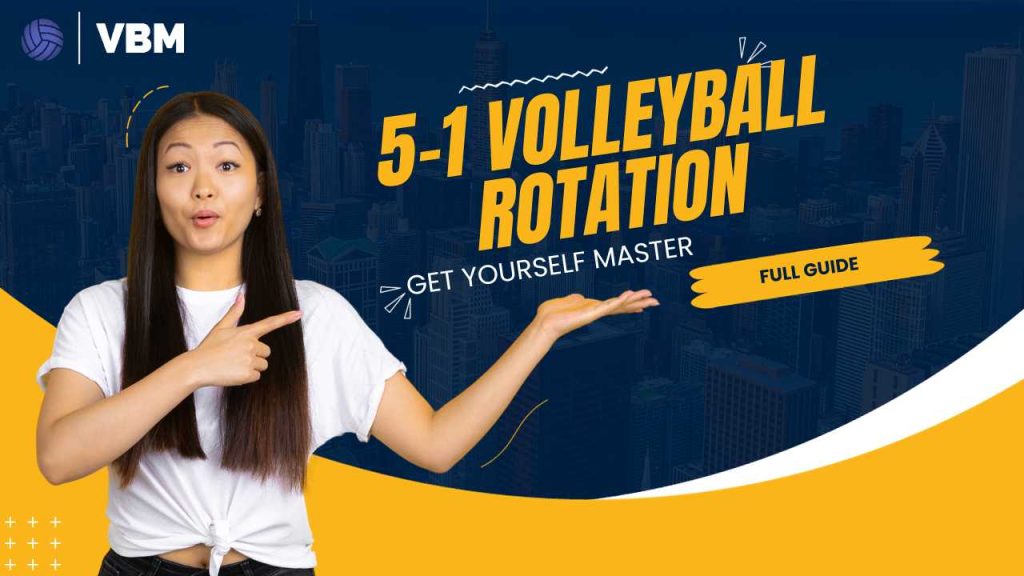If one setter is significantly better than the others, if a setter is tall enough to pose a blocking danger, or if no-hitter is available to replace the setter in the front row, the 5-1 rotation is frequently used. The 5-1 volleyball rotation always has 5 hitters and 1 server on the court. The benefit is a consistent setup, which should make it simpler for the hitters. The drawback is that there are only two eligible hitters in three of the rotations. This will become less of a disadvantage if a setter can use dumping to position herself as an offensive danger. Volleyball Mania is an online hub for all things related to volleyball.
How Rotations Operate
We will now discuss the 5-1 volleyball rotation system’s principles. Keep in mind that when talking rotation, players are denoted by a common numerical indicator method. Each position must be in its proper rotational spot, and the rotation must be maintained in its sequential order. Players may move objects around as long as they don’t obstruct another rotational location, though. A penalty is assessed for overlapping the person in front of or beside you because it puts you out of rotation.
Rotation 1
The base set is adjusted during the first rotation to put your setter in the best possible place for priming and readiness. The host advances to the front right of the net without moving in front of player 1. Since the setter moved up, player three, who initially begins at front-left, moves back into serve-receive to assist numbers four and five.
The setter moves to its natural setting stance towards the middle as soon as the serve is contacted. The others must transition into their positions for hitting and defense at the same time. Keep in mind this one conflicting safety measure. The setter is not permitted to pass in front of Player 1 or nearer the middle than Player 5.
Rotation 2
Additionally, the second rotation enables the setter to begin relatively near to the location of their preferred setting. The setter is now in the back-middle position to commence after rotating clockwise. The setter will then nudge up player three in preparation for serve-receive from there.
Player three immediately returns to the hitting position after receiving the serve, with the server already in place. Again, this rotation has some overlap issues that should be carefully considered, particularly in the back row. Player 5 and Player 1 are both regarded as back row players, so the setter must be careful to prevent being crossed over by either of them.
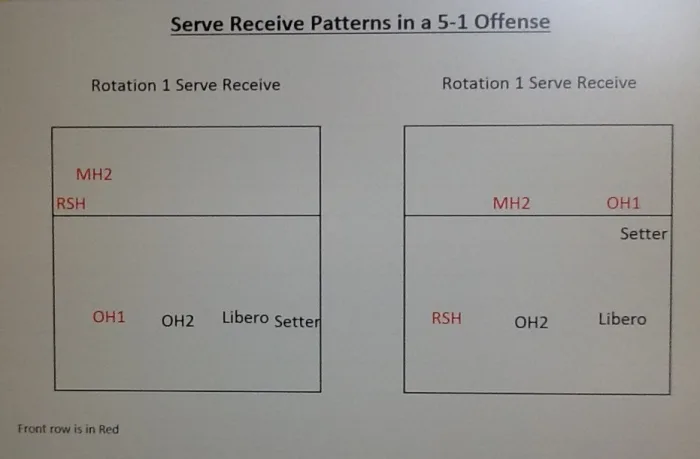
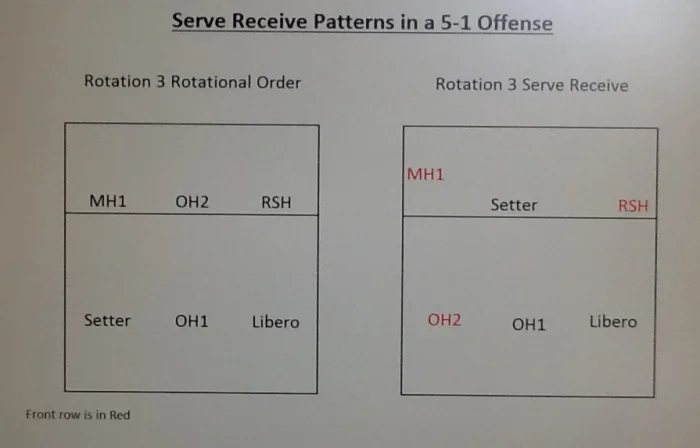
Rotation 3
The third rotation mirrors the first in many ways but in the opposite orientation. The server is currently in the rear left position and ready to launch. Player five is pushed up to the net by the server, and player four is pulled to the left. They can easily reach their outside position because of this. Being so far from their optimal setting placement presents a challenge for the setter in this position.
The setter must run to their right-of-center location as soon as the ball is contacted for service. Player three, who initially took the right-front position, will move back to help with serve reception. The only real issue with overlapping is when the setter leaves too quickly for their position and player one, who is positioned to the left for serve receive, overlaps them.
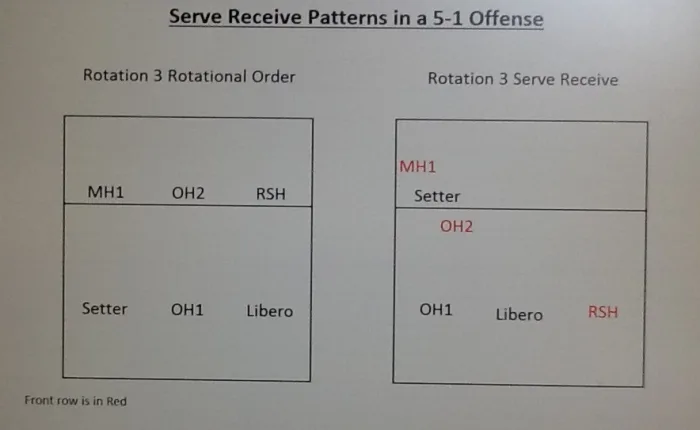
Rotation 4
The server is introduced to the front row in rotation four. Everyone’s life is made much simpler as overlapping is no longer a major issue. To help the setter get to their spot swiftly, the front-row players can be as close to one another as needed while still maintaining proper numerical order. The placement of the players is much more flexible once the setter moves into the front row. Because of this, hitters can easily “switch” positions before initiating any offensive plays.
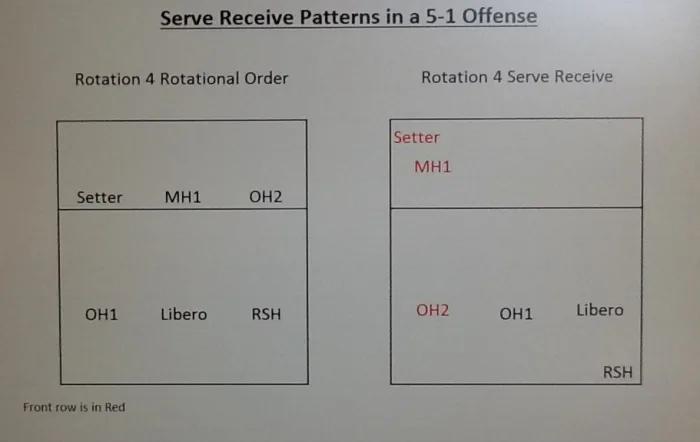
Rotation 5
Since the setter is not in the front-middle position in rotation five, it is perfect. This setup is also very adaptable for staging shows. The setter can even order that passes be made closer to the middle, which would prevent a middle assault but would still leave room for two outside hitters to contribute. A player on the outside position can also move into the center to attack as an alternative.
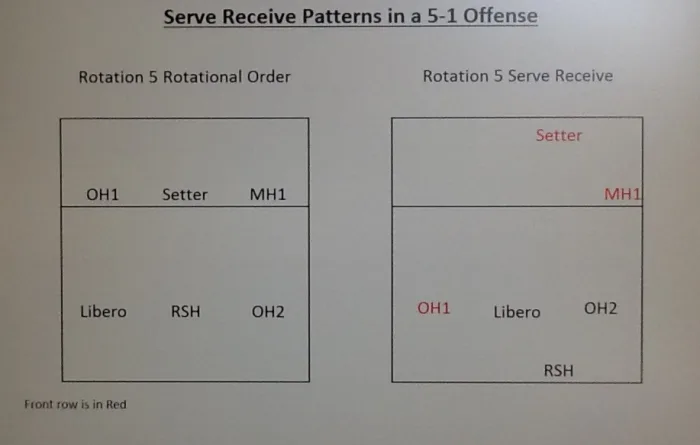
Rotation 6
The last revolution before the cycle is restarted is rotation six. The setter is already in a position to easily set from the front-right spot, so the front row stays very flexible. The setter’s call of the move determines where the front-left and front-middle hitters can place themselves to hit from. A back-row player is frequently placed behind the ten-foot line by the setter. (3m line). This makes it possible to strike deeper on the other team’s court off the net.
Read More: Best Socks for Volleyball
Benefits of the 5-1 Volleyball Formation
Creates a strong bond between the Hitters and Setters
The fact that the setter in this formation is always the same person has the enormous advantage of fostering strong communication and relationships between the setter and the hitter. Knowing that the setter can always strike the sweet spot with their set and maintain the same tempo gives hitters a tremendous confidence boost. This connection, in my opinion, is especially crucial between middle hitters and setters.
It is crucial for the setter to know precisely where to place the ball when the middle is running in at lightning speed because otherwise, the middle may have to play a safety shot or even miss the ball entirely. There is no greater illustration of this relationship in volleyball than Bruno and Lucas, two Brazilian internationals.
Strengthens Stability
Touching on the aforementioned point, because the players are aware of the timing and pace of the set, they become much more stable. All players benefit from numerous repetitions in their favored positions thanks to this formation. In contrast to other arrangements, where the setter only sets when necessary. With so many attempts available to the setter during this rotation, regularity can only improve.
Offers the most creative and setting options:
Simply the amount of creativity it provides the team and the sheer number of setting options accessible, in my humble opinion, is one of the main benefits. Running this configuration offers unparalleled opportunities for creative sets and elaborate players. It gives you a lot of freedom as a setter, and if the pass is reliable, you can set it just about anywhere on the floor.
Front Row Assault:
In the instance of the 5-1 volleyball rotation, there are advantages as well when the setter moves into the front row. When the ball is too close to the net, a 5-1 setter in the front row can attack, enabling a tap over or “dink.” Additionally, having a 5-1 setter in the front row gives the middle blocker room to execute plays behind the setter.
From professional-level tips to beginner-friendly advice, Volleyball Mania is a must-visit destination for anyone passionate about the sport.
Disadvantages of the 5-1 System:
- A team will have three of the best blockers in the front row in three rounds of the 5-1 system, and two of the best hitters and blockers in the other three rotations.
- Due to their specialization and the degree of play, setters are typically shorter than their counterparts.
While using fewer players, the volleyball 5-1 method of play ensures consistency in both sets and court leadership. The drawback of having a front row with either three excellent blockers or two very good hitters and blockers is that the 5-1 system requires specialization, which makes setters shorter than their counterparts.
